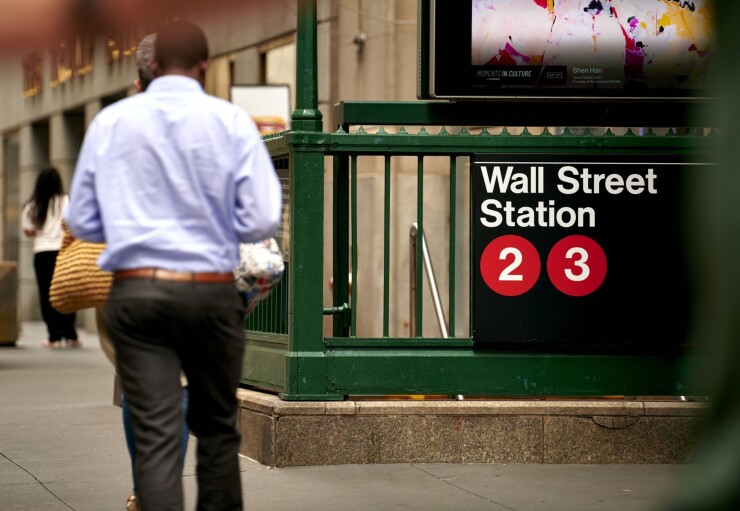For the second time in as many weeks, the New York Metropolitan Transportation Authority has gotten some good news.
S&P Global Ratings on Tuesday raised its long-term rating and underlying rating (SPUR) on the MTA's transportation revenue bonds (TRBs) to A-minus from BBB-plus.
S&P upgraded the long-term component of its dual ratings on various MTA variable-rate TRBs with enhancement by letters of credit from the Toronto-Dominion Bank to AA from AA-minus, while the short-term component remained at A1-plus.

S&P also upgraded the long-term component of its dual ratings on various MTA variable-rate TRBs with enhancement by LOCs from Bank of America, Bank of Montreal, Barclays Bank and PNC Bank to AA from AA-minus, while the short-term component remained at A1.
"The rating action is spurred by improving ridership performance as well as increased financial flexibility and operating stability resulting from the state of New York's decision to raise the payroll mobility tax (PMT) to enhance one of MTA's recurring revenue sources to help offset lower fare revenues," said S&P credit analyst Joseph Pezzimenti.
"The essentiality of the transit system, evidenced by the strong support provided to the authority at the federal, state, and local levels during and following the pandemic, was also a key consideration," he said.
The outlook is positive, S&P said.
New York officials were ecstatic Tuesday night.
"The budget investments we made this year will make transit better for commuters throughout the region," said Gov. Kathy Hochul. "I'm pleased to see S&P recognizing these investments through the improved rating outlook and an improved bond rating."
The upgrade is expected to boost investor confidence in the MTA and could lead to lower interest rates on future capital program bonds issued using the transportation revenue credit.
"There's a reason Wall Street is expressing confidence in the MTA's financial condition: the bold leadership demonstrated by Gov. Hochul in the 2023 NYS budget," said MTA Chair and CEO Janno Lieber. "While transit agencies nationwide are struggling with impending financial crises, the MTA has five years of balanced budgets and is adding, rather than cutting, service for New Yorkers."
A one-time subsidy of $300 million by the state from new dedicated revenue funding sources help offset lower fare revenues from reduced ridership after the COVID-19 pandemic. These sources include an increase to the PMT, an increase by the city to its funding for paratransit and other dedicated taxes in the fiscal 2024 state budget along with fare and toll increases, which have strengthened the MTA's financial profile.
Post-pandemic ridership recovery continues to track the mid-point of a range predicted by McKinsey in July 2022, the MTA said, adding, daily ridership now surpasses two-thirds of pre-COVID levels.
The credit rating outlook of the TRBs, backed by revenues including fares and tolls paid by riders and from state revenue streams, reflects the performance of the operating budget and is a barometer of the MTA's overall financial health, according to the authority.
"We are pleased that today's upgrade from S&P recognizes the MTA's improved financial stability, including five years of projected balanced budgets, demonstrated state and city support with recurring revenues, and strong ridership recovery, consistent with our financial plan projections," said MTA Chief Financial Officer Kevin Willens.
"The positive outlook reflects our opinion that there is at least a one-in-three chance we could raise the rating over the two-year outlook period if MTA is able to meet or exceed near-term expectations," S&P said. "Better clarity regarding the cost and funding plan of the authority's next capital program will also be an important consideration."
And there could be more good news in the next few years.
"We could raise the SPUR over the two-year outlook period if the MTA is able to meet or exceed near-term expectations and can maintain all-in coverage near 1x as it debt-finances a portion of its capital programs," S&P said. "The impact of congestion pricing on tunnel and bridge tolled traffic, details regarding the cost and funding plan of MTA's next capital program, and where ridership ultimately settles will be important considerations."
Still, S&P said it could revise the outlook to stable if weaker fare revenue and toll revenue performance causes persistently weaker all-in net debt service coverage trends or if it believes the funding of the authority's next multiyear capital program will pressure financial metrics.
Before the pandemic, the TRBs were rated A with a negative outlook by S&P. In March 2020, the bonds were downgraded to A-minus and in July 2020 were cut to BBB-plus with a negative outlook. In March 2021, S&P acknowledged that the federal COVID relief made available to the MTA was helping the authority and revised the outlook to stable.
Late last month,
At the same time, Moody's affirmed the A3 rating on the MTA's $20.6 billion of outstanding TRBs.
The MTA TRBs are also rated A-minus by Fitch Ratings and AA by Kroll Bond Rating Agency.





